This fermented honey garlic is the perfect thing to make to boost your immune system! Both honey and garlic have strong medicinal benefits, so you’ll want to have this delicious home remedy on hand for cold and flu season.
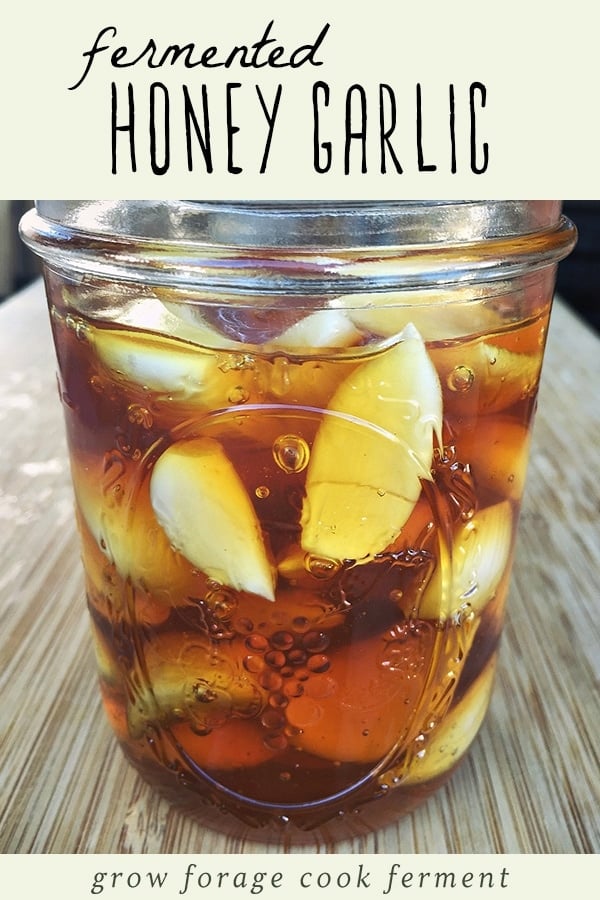
Want to save this post for later?
Fermenting Garlic in Honey
I’m really excited to share this post with you! Fermented honey garlic is something I’ve been wanting to try for a very long time, ever since I first read about it on the Killer Pickles blog.
I usually reserve my honey for mead making, but using it for other ferments intrigued me. Don’t ask me why I haven’t done it until now, because it’s the easiest thing in the world!
This tasty fermented garlic in honey can be used for many things, as good food and good medicine. Honestly though, I like to just eat it as is!
Fermented Honey Garlic Recipe
Making fermented honey garlic is so easy, it hardly needs a recipe!
Prepare the Garlic
The hardest and most time consuming part is prepping all of the garlic. Whatever size jar you use, you’ll want to fill it about 1/2-3/4 full of peeled garlic.
The quickest and easiest way to prep garlic is to place the side of a chef’s knife on top of a single clove and then give it a firm whack with the palm of your hand.
Don’t do it too hard, as you don’t want to crush the garlic, but just enough to lightly bruise the it. This will make it easy to peel, and will also release a bit of the garlic juice.
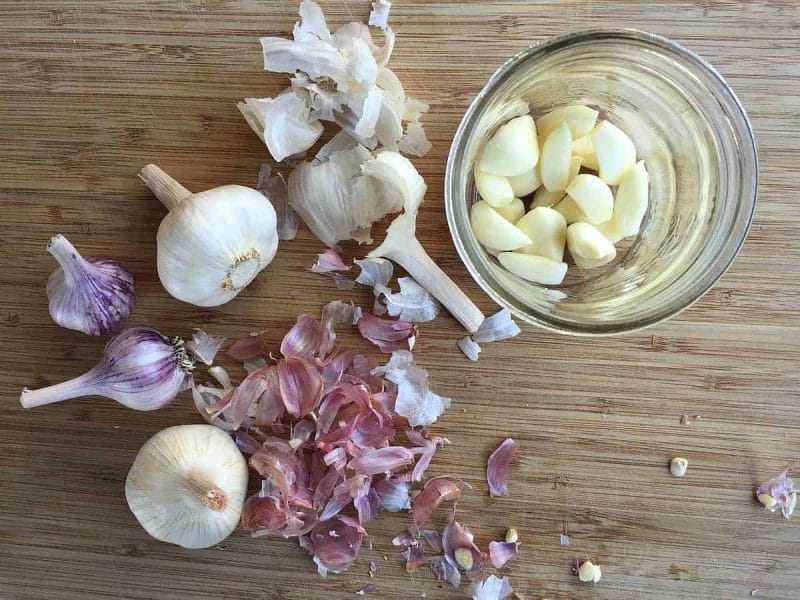
Add the Honey
Once you have enough garlic in your jar, pour in some raw honey to cover it. The garlic will probably float a bit and that’s ok.
It’s important to use raw honey to make fermented garlic in honey, as it will still have all the bacteria and wild yeast that is necessary for fermentation.
When liquid is added to honey, it jump starts the fermentation process. The small amount of juice from the garlic will create just enough liquid for fermentation to happen.
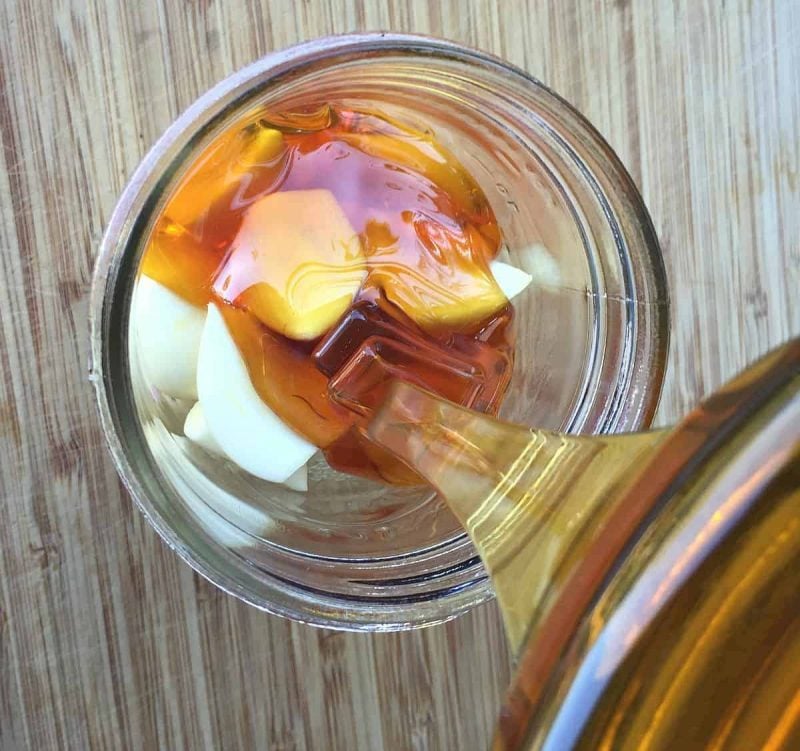
Cover and Flip
Cover the jar loosely with a lid to let the gasses escape, and put it in a dark place to ferment.
It’s a good idea to put a plate or something similar underneath the jar as it’s fermenting, as it will likely bubble up a bit and a little honey could possibly drip out.
It’s also important to gently turn the jar over every day or so, or whenever you think about it, to make sure that all of the garlic stay coated with honey.
Screw the lid on tightly before you do this! Then return it to it’s upright position and re-loosen the lid.
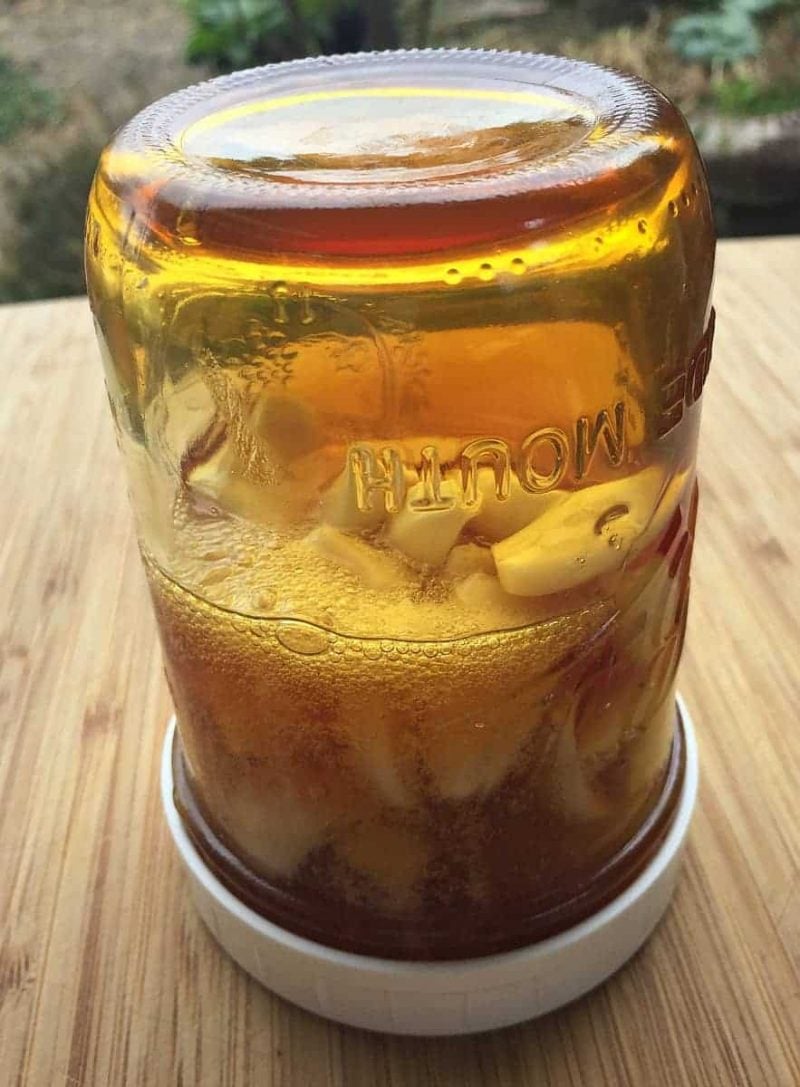
In a few days to a week you will notice some bubbles forming on the surface of the honey. Hooray!
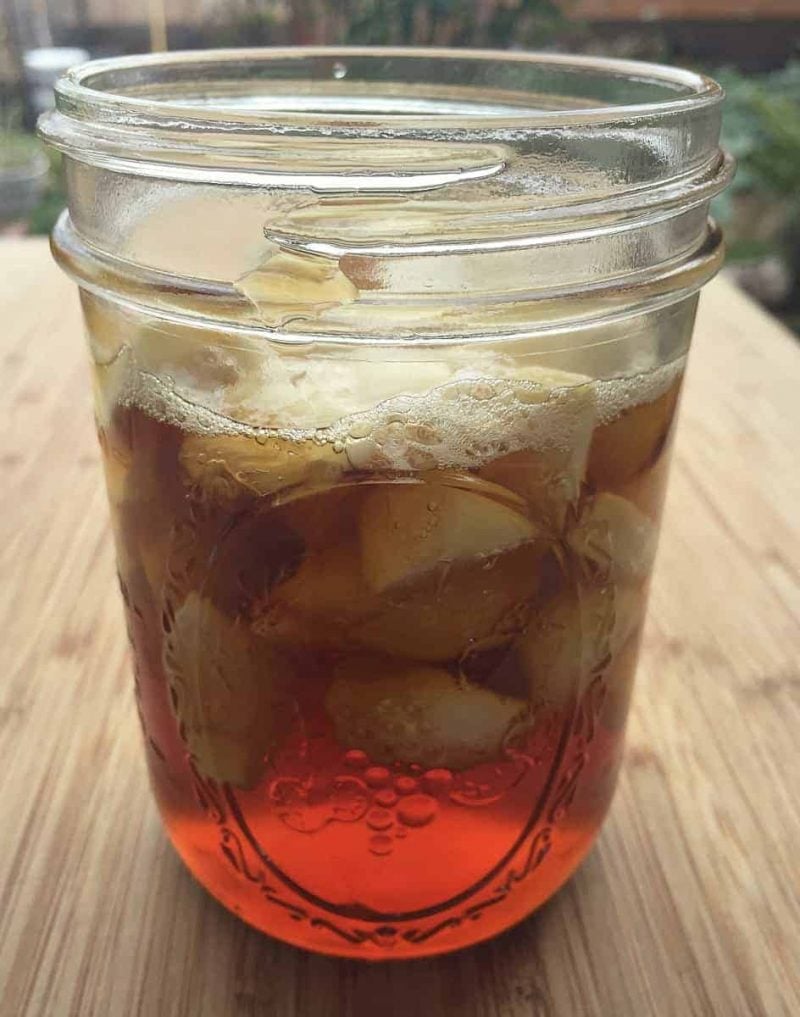
The honey garlic will ferment for about a month, but you can eat it at any time during the process.
The flavor will continue to develop over time, the garlic will mellow, and the honey will become much runnier.
Occasionally the garlic cloves turn a blue or green color due to a reaction during the fermentation process. While it may be a bit alarming, it is not harmful and the honey garlic can still be used.
Honey garlic will store well in a cool place for many months, or even a year or longer! I’ve kept some for over two years and it is still good.
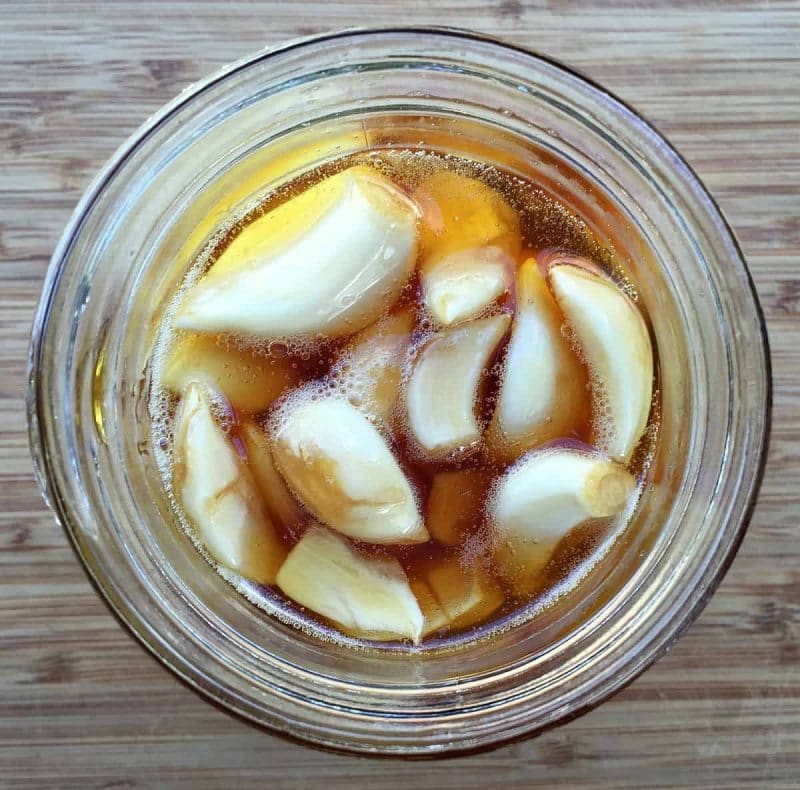
Using Fermented Honey Garlic
Now, how do you use this fermented honey garlic? That’s a good question, and it can be used in a variety of ways.
Both garlic and honey have strong medicinal properties, so it makes sense to use it as an immune booster or if you feel a cold or flu coming on.
Pop a whole garlic clove, or take a spoonful of honey (or both!).
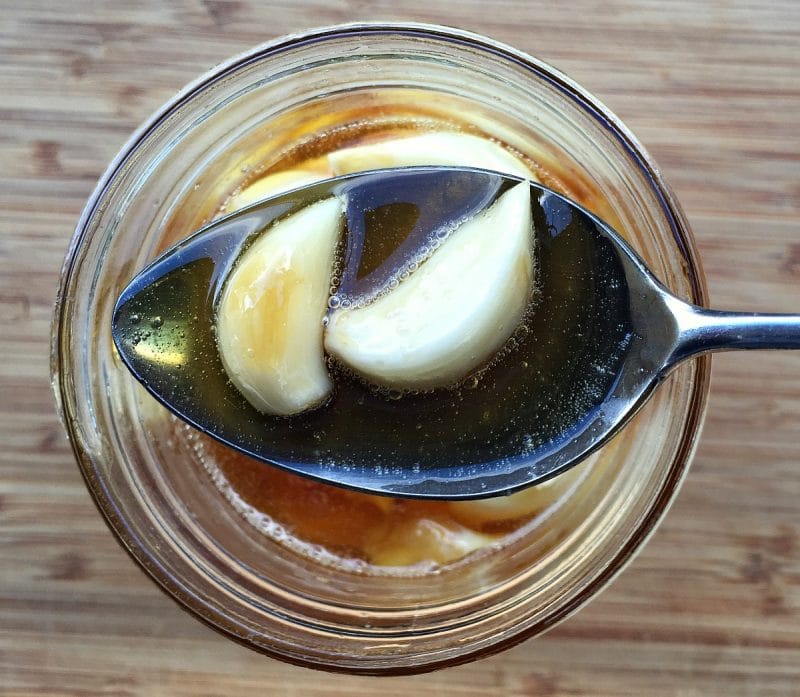
As you can probably imagine, honey garlic also makes a wonderful food!
It’s a natural in marinades and sauces, and would make a really tasty glaze for meats or veggies. Basically anything where you would normally use honey and garlic together!
Is Botulism a Concern in Honey Garlic?
I get this question a lot about fermented honey garlic! The short answer is no, botulism is really not a concern in this type of ferment.
While botulism can happen in garlic and oil preparations without added acidity, the fermentation process that happens here makes it very unlikely.
Raw honey is acidic, and while it can carry botulism spores (which is why it is not recommended for babies under 1 year), the level of acidity stops them from reproducing, which is what causes botulism.
If you are concerned about it, use a pH test strip. Botulism spores can’t reproduce with a pH of less than 4.6. Honey is usually around 3.9, but that can vary between brands.
If the pH is too high, add a splash of raw apple cider vinegar to add more acidity and retest. This is generally not needed, but I did want to mention it.
Honey garlic should not be given to babies under one year of age.
I really hope you make this yummy honeyed garlic! It’s super easy, and great to have on hand. I have a feeling it’s going to become a staple in our house!
Have you ever made fermented honey garlic? How do you use it?
More Fermented and Infused Honey Recipes
Enjoy these other recipes that showcase fermented and infused honey!
- Fermented Honey Cranberries
- Fermented Elderberry Honey
- Herbal Infused Honey
- Lilac Flower Infused Honey
Fermented Honey Garlic
Equipment
Ingredients
- 1 cup whole garlic cloves peeled and slightly crushed
- 1 cup raw honey or more, as needed to cover garlic
Instructions
- Place the peeled garlic cloves into a wide-mouth pint sized mason jar. Add enough honey to completely cover the garlic cloves. Make sure they are coated with honey.
- Place the lid on the jar loosely, then tuck into a dark place.
- Every day or so, tighten the lid on the jar and flip it upside down to coat the garlic cloves with honey. Loosen the lid again when you return it to the upright position.
- Within a few days to a week, you should see small bubbles start to form on the surface of the honey.
- The honey garlic will ferment for about a month, but you can eat it at any time. The flavor will continue to develop over time, the garlic will mellow, and the honey will become much runnier.
- Store in a cool place for many months or even a year, if not longer.
Notes
- It’s important to use raw honey for this recipe, as it has all of the bacteria and wild yeast that is necessary for fermentation.
- The small amount of juice from the garlic will create just enough liquid for fermentation to happen.
- It’s a good idea to put a plate underneath the jar during fermentation, as it will likely bubble up and a little bit of honey could possibly drip out.
- Occasionally the garlic cloves turn a bluish or greenish color during the fermentation process. While it may be a bit alarming, it is not harmful and the honey garlic can still be used.
- If you are concerned about botulism, use a pH test strip. Botulism spores can't reproduce with a pH of less than 4.6. Honey is usually around 3.9, but that can vary between brands.
- If the pH is too high, add a splash of raw apple cider vinegar to add more acidity and retest. This is generally not needed, but I do want to mention it.
- Honey garlic should not be given to babies under one year of age.

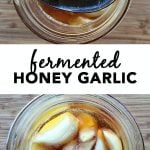
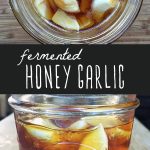
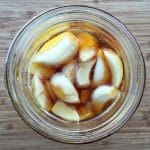

I happily peeled garlic this weekend and filled a quart jar. I did put an airlock on mine…which I hope is okay. I also am a little worried I filled it to full. ;-) I may have a mess. Thank you for the pretty pictures and the nice article!!! I’m looking forward to trying the garlic!!
I saw Bon Appetite make this on YouTube and thought it was fantastic. I will definitely try this very soon as we’ve been getting into fermenting foods. I would love to have a few jars of this on hand for culinary and medicinal uses! Thank you for a lovely post! :)
Is it okay to have the garlic honey at night and not on empty stomach? I see most recommended for empty stomach in the morning but I don’t like the bad breath through the day. Please suggest.
Whenever you want to consume it is perfectly fine :)
Mine didn’t bubble.a lot. It’s been going for a few weeks & I’ve got it in a closed cabinet. Any ideas on why?
Did you use local honey, or honey that was from an unknown source? I would take a stab in the dark and say if the honey was store bought, it might be cut with corn syrup and thus making the honey less effective. Or if your cabinet is in a cold (50 degree Fahrenheit or less) location, it could slow the fermentation process. Good luck!
THE raw honey I ha e is very thick, almost chrylized form. I can’t pour it… actually can’t even see through the honey. But I’m thinking if I heat it to melt it, that will kill the good bacteria. It’s the only raw honey I can feel be in my area.
Heat in a pan with water. Only heat to start melting process.
I’ve been advised to never heat honey in the microwave. My honey got cold, and hard. It took me a couple of days to bring it to a pouring stage.
I would love to combine this recipes with some fresh herbs (like thyme, sage, oregano) in order to make a more potent syrup for lung ailments. How would you approach this? Would it be ok to throw it all in together, or infuse the honey with the herbs for some time first? Thank you :)
I used some organic garlic that had been soaked for a day on my counter in water and sea salt. I was originally going to ferment my garlic in a different way. I rinsed it off and then followed your recipe. Do you think it will still be fine?
Yes, I think that will be just fine!
Thanks!!
I did this and my garlic changed color and got darker in color. Is that normal and still safe to consume?
Please see above comments about this.
I too had my garlic turn dark. Almost the color of the honey and it is quite strong smelling of the garlic and the honey is super garlicky. Like in the fermenting it’s getting stronger not mellowed. I read all the above posts but saw nothing about the garlic going dark, just green. Tastes good and not like it’s spoiled just under garlicky. I’m assuming it’s fine?
Also honey & fresh cranberries are great; with ginger of course!
What is the purpose of adding ginger to the cranberries & honey? Benefit? Flavor??
Thanks for sharing! I love finding herbal flu tonics and I hae used garlic medicinally so many times! With our livestock too!
Can I add chilli, Lime, ginger and garlic all at once?
I think you could, and that sounds pretty tasty!
After about 11 days I noticed this morning some of the cloves in one jar have a green tint through part of the clove, . Have you ever had anything like this?
I’ve heard of this happening with honey garlic, although I’ve never had it happen myself. From what I understand it’s harmless, but you may want to research it further to be sure.
I did a batch of honey garlic crushed; yes it turned green! I did eat this, and was fine, I use it as a medicine, for I suffer with chronic Asthma & get upper respiratory infections, since this concoction I have been doing great! Happy fermenteing????
When I had the green tint on some of the cloves, I found that it was because the garlic was sprouting inside. This most likely began before starting my ferment. No worries!
I love garlic in and of itself, so the idea of garlic being infused with honey sounds absolutely delicious! I love roasting garlic in the oven until it becomes soft and delicious – I can’t even imagine what this would taste like adding in honey. Thank you for this recipe! I can’t wait to try it.
So when bubbling stops, is that the end of the fermenting process and time to be placed in fridge?
It will continue to ferment slowly for many months. Unlike most other ferments, it does not need to be kept in the fridge. It will keep for a year or longer in a cool, dark place.
Hi, I started this a few weeks ago and watched as it bubbled…now that it is time to try it, the honey is runnier, as mentioned, but there is no more bubbling going on at all. Is that right?
Yep!
Do you think this would work using small yellow onions? Trying to find a way to get raw onions and raw garlic into my daily diet. You solved the garlic recipe. Just wondering about the onions. Also, someone else mentioned using ginger. Could I break up the ginger into small pieces and before peeling them?
Yes, I have heard of people using onions in a similar way – I bet it would be delicious!
onions and honey is an amazing cough syrup!
I know this is older but you may still like the suggestion. You can lacto-ferment raw onions and garlic together and it is amazingly delicious. Just put garlic cloves and as much sliced onions into a jar as you can cram in there. Cover it all with a brine made from water and salt at a ratio of 1 tsp salt per 1 cup of water. Make sure to use salt with out iodine or any other fillers. Cover loosely or use fermenting weights and lids and let sit for a month or more. Makes super yummy low sugar fermented onions and garlic.
Awesome! Can I use Himalayan salt? Or pure sea salt? Thanks
Does the garlic have to stay below the honey like veggies have to stay under the water when fermenting them?
No, and it probably won’t. As long as you are turning your jar every day and coating the garlic with honey it should be just fine!
Can you use raw honey that has started crystallizing?
You could, but it would be hard to pour it in and combine with the garlic. You could try heating it up just barely (not too much, as you don’t want to kill the good bacteria) to see if it will become a little runnier and easier to work with.
This suggestion is probably too late and no longer matters, but to melt crystalised honey fill a pot of hot tap water ( probably around 45c) and put the jar of honey into it. Let it sit in the water till it cools and repeat as many times as needed. This method is too gentle to kill the good bacteria but enough to melt the honey.
I’m definitely going to begin my fermentation. This recipe and other suggestions sound so good!
Can you add fresh Raw honey if you use just the honey and still have the cloves?
Hmm, I’ve never tried that, so I’m not sure. You could probably do at least one more round of honey, but it may not be as strong as the first batch.
Wow… Both raw honey and garlic are notorious for botulism… And how you are making this is a perfect way for C. bot to grow… Be careful everyone…
While botulism can happen in garlic and oil preparations without added acidity, the fermentation process that happens here makes it very unlikely. Raw honey is actually acidic which helps, and while it can carry botulism spores (which is why it is not recommended for babies under 1 year), older children and adults eat it all the time. I probably wouldn’t give this to an infant, but I think the risk for botulism is extremely small, if at all. People have been doing this ferment for a very long time without ill effect.
Adding a bit of raw apple cider vinegar if you are worried. There exist tools to measure the PH.
You’re bang on the money. Botulism can’t exist above 4.6Ph, so monitor it (dip stick tests) and add organic apple cider vinegar if the Ph dips too low.
I’m sorry, its below 4.6pH, not above. Just wanted to be clear.
where would one get these? I made a batch and it’s supposed to be ready to eat but it wasn’t until after I’d started it that I thought about the possibility of botulism. If the pH is too low, would adding the ACV still work? I want to try this, but eep…
My fermentation came out at 5.5pH. Added the ACV, hoping it’ll help, even at this point.
Also, it never did bubble a whole lot, is that normal?
Yes I agree! Please be careful!!!!
You say to use raw honey. How can one buy that? Can one use ordinary shop-bought honey?
It needs to be raw, because then it will have the necessary bacteria and yeast still intact for fermentation. The packaging should say raw. If you can’t find any in local stores, you can get it on Amazon here: http://amzn.to/2eCqfva
http://www.foodrenegade.com/your-honey-isnt-honey/ Another reason to buy local raw honey is that most store bought honey IS NOT honey. To be honey it MUST have the pollen in it. Most, about 76% does not. Why remove the pollen you say. To hide the country of origin. Most honey sold today is from China and has bee n cut with High Fructose Corn Syrup.
this is true! You can also do this in a canning jar with lid :)
Great idea. I’ll be starting some very soon. Just a thought… If you break the garlic into individual cloves you can place all of them in a large bowl, preferably metal or wood. Cover tightly and shake it very hard for a minute. Open and all your cloves are peeled. Just sort em out. Also lightly bruises the clove. I think that is mostly for looks.
make sure your garlic is not from china. it is unfit for human consumption
I used locally grown garlic from the farmer’s market :)
FYI, most garlic sold in the US, ans not specifically labeled as grown in the US, is from China!!
I was taught that you can tell Chinese garlic by the lack of roots because its illegal to import garlic with even tiny roots.
Plus it has very little flavour (I guess that’s why it’s cheeeeep ! ) compared to home grown.
I will for sure try this! Thanks so much for sharing!
Thanks for the tip Colleen, I appreciate your blog with all the tips and ideas.
I’m gonna make this asap so I can eat it ASAP! Thanks for the tip ! … soon as i finish cleaning todays haul of porcini :)
I wonder how it would be with fresh ginger chunks added???
That sounds like it would be really good to me!
I used organic garlic and organic ginger and organic red onion and Manuka honey
Just waiting for the time to eat
That sounds amazing
Cindi ~ Ginger slices are divine in this concoction! Sometimes I’ll layer thinly sliced lemon, whole garlic cloves, sprinkle with some good turmeric (can’t find fresh turmeric here very often) & then the ginger slices (however thick or thin you like)..really in any order you want to layer is just fine….keep layering till the jar is 3/4 full, then pour a good quality honey over it …. you talk about good stuff !!!! I have 2 jars of just the garlic & honey that I made last December & it is delicious. By this time the garlic is very, very mild & the honey is yummy. Great for colds & whatever else ails you. I cook with the garlic sometimes & put a teaspoon of the honey in a cup of tea or just take a big teaspoon of it plain ;)
Does it last longer than a year? Do I need to refrigerate it after the ferment process? Or just screw the lid on tightly and keep in a dark place?
Based on a fermentation class I took, it must be refrigerated after fermentation stops.
Unlike most other ferments, it does not need to be kept in the fridge. It will keep for a year or longer in a cool, dark place.
Does this fermentation produce alcohol?
Will cooking kill the good bacteria and other benefits ?
David, from what I understand, this won’t produce a lot of alcohol. If you Fermented fruit in honey, longer ferments will produce alcohol.
Lynn, Yes, cooking destroys the good bacteria in the ferment.
Look for small plastic bags of turmeric roots in the refrigerated produce department of asian markets. Good luck
You can order fresh from amazon
I agree with the Asian grocer comment. That is where I get mine. Amazon also carries fresh turmeric. Also whole foods.
Pam you can get fresh tumeric online.
I did add fresh ginger to mine it has been fermenting about a month not much flavor difference in the honey but very good when eating a piece of garlic and ginger together I believe it should boost the anti imflamation content just a thought
Great idea!
So does fermented garlic and honey help people with inflammation problems? And how often would I eat it for inflammation?
Ooooh. This sounds great! Any reason why it would be bad to crush the garlic when getting it out of it’s skin? Thanks for sharing.
It’s not necessarily bad, but it may not keep for as long. Most recipes I see say to leave it whole, but now that I think of it I’m not really sure why that is!
Hi,
By crushing the garlic the allicin in garlic will be lost which is the important part of the garlic. Allicin cure all the diseases. If you the webpage you will find it.
Thanks
almas
You’re actually incorrect in this.
You DO want to crush the garlic. Allicin primarily forms in the garlic as a defense mechanism, i.e. when the garlic sustains some kind of damage by chopping or crushing. It is actually alliin that is being converted into allicin by an enzyme called alliinase. So truly, when making this, you DO want to crush it, and you want to leave it on the countertop for about 10 minutes prior to starting in order to allowing as much allicin to develop as possible.
Good to know!
You can just mince and leave for 10 mins, doesn’t have to be crushed
I disagree about the recommendation to crush or chop the garlic for this recipe, and here’s why, with the caveat that this is just my understanding of the biochemistry of allicin.
It is true that allicin is produced when garlic is crushed – the precursor (alliin) and the enzyme that converts it to allicin stay separate until the garlic is “damaged”. In the normal environment, the type of “damage” that garlic was defending itself from was microbial attack (i.e., mostly yeasts and bacteria). If you crush the garlic cloves first, the allicin is activated and then will be used to fight the wild microbes in the raw honey. That is the opposite of what you want to do. Instead, leave them whole, let the honey microbes start to break down the garlic, and that is the natural process that releases allicin into the honey so you can benefit from it. The allicin will also still be trying to work against the fermentation, but it just keeps it slow and probably has a selective effect on which microbes flourish or not (there are lots of studies on the effects of allicin on different species of bacteria).
If you aren’t going to ferment the garlic, however, by all means do crush it up if you are looking for maximizing allicin.
Thanks for this, I just found out about this yesterday & had to stop on my way home to get my garlic & raw honey! Thankfully I hadn’t started yet, so now I know what f why!
If you place the whole garlic head into a old pickle jar, put cap on and then shake vigorously it will not only break the head up but also remove all the skin leaving it lightly bruised.
I used raw unfiltered honey and it came out awesome. The combination of powerpacked raw honey and garlic and then the fermentation process make this treat better than gold. Thy food is thy medicine , Copernicus’s
You actually do want to crush the garlic a little bit because when you crush it, it creates the allicin and it is garlic’s natural defense system and that is what’s really good for you in garlic.
This sounds so good! Easy, too!